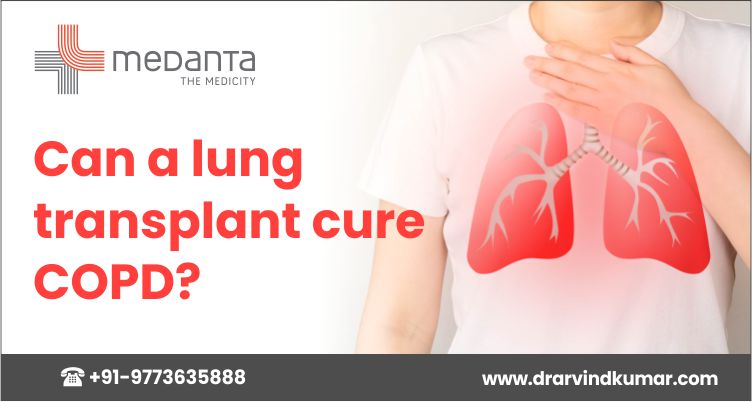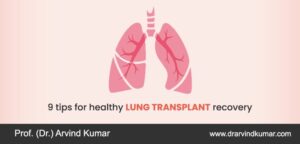COPD, also known as chronic obstructive pulmonary disease, is a collective term for a group of respiratory conditions that hampers the lungs ability to expel air. It is the third most common cause of death across the globe. COPD causes congestion and cough, which makes it difficult for the person to breathe. Generally, medicines can help in easing out the symptoms of COPD. But when COPD reaches an advanced stage, it can lead to the development of lung cancer, heart disease, and health problems and frequent secondary infections that can cause early death. Thus, in such cases, lung volume reduction surgery or lung transplant is the only treatment available to improve respiration.
Now, the question arises under what indication is a lung transplant indicated, and what is its survival rate or life expectancy in cases of advanced COPD? So in this blog, let us look at lung transplantations role in patients with COPD.
What is COPD and its symptoms?
Before we deal with more complex questions, it is important to know what COPD is and its associated symptoms. COPD is an umbrella term for several respiratory conditions that interfere with a persons normal breathing. COPD is of several types, the most common of which is emphysema. The most common cause of COPD is exposure to allergens that irritate your lungs. The most common symptoms of COPD include:
- Chronic cough that produces excessive mucus
- Cyanosis that is, fingernail beds and lips turn bluish colored
- Lack of energy
- Swollen legs, feet, or ankles
- Shortness of breath, specifically while you exercise
- Pain or tightness in the chest
- Wheezing
Who is an ideal candidate for lung transplantation?
Not all COPD patients are advised for lung transplantation surgery. In most cases, medicines alone can help relieve COPD symptoms. There is a certain criterion that a patient should meet in order to get a lung transplant done. The criteria set by the International Society for Heart and Lung Transplant include the following:
- The patient is being given proper treatment, but their health is still worsening.
- The patient has entered the hypercapnic state, which is characterised by excessive carbon-di-oxide in the blood that can lead to future complications.
- The patient has entered the hypoxemic state, which is characterised by too little oxygen in the blood.
- The forced expiratory volume of the patient in 1 second is 25% less than the normal value. Forced expiratory volume refers to the amount of air that a person can force out of their lungs in 1 second.
- According to the American Thoracic Society, you can get lung transplantation done if you have a BODE index score (a system that predicts your risk of dying due to respiratory conditions) of at least 80%.
- If you have had more than three severe COPD exacerbations in the past year.
- If you have moderate to severe levels of pulmonary hypertension.
What is the survival and life expectancy of COPD patients after getting a lung transplant done?
A lung transplant is an effective treatment option for increasing the quality of life and short-term survival of patients with COPD. However, scientific research still does not validate the long-term life expectancy of COPD patients with lung transplantation. 91-92% of COPD patients who have had a lung transplant have reported surviving for at least 3 months after the transplantation. According to the National Health Society (NHS), 50% of the patients with successful lung transplantation survive for at least 5 years after the surgery. However, certain studies regard lung transplantation as the only treatment that can improve the long-term effect in patients with advanced COPD.
What does the postoperative period look like for COPD patients?
Lung transplantation in a COPD patient demands the utmost care in the postoperative period. The several measures that are taken after the surgery include:
- Monitor body vitals to check how well your body accepts the transplanted lung. This is also done so that any side effect or complication is diagnosed as early as possible.
- Anti-rejection medicines are also given to prevent the rejection of the transplanted lung. These medicines suppress your body’s immune response, making it possible for the body to accept the new lung.
- Pulmonary rehabilitation, including physical therapy and breathing exercises, is prescribed after some days of the surgery. This also prevents the formation of clots after the surgery.
- It would be best if you avoided strenuous exercises, including climbing stairs, for some days after the surgery.
- It is important to look for any signs of infection post-surgery. Chills, fever, swelling, and oozing out of fluid from the incision site are some of the common symptoms of infection.
- You must also consult your doctor if your shortness of breath does not improve over time.
At the end
A lung transplant is the surgical replacement of a lung that has stopped functioning. A lung transplant might not be a permanent solution for COPD patients, but it surely contributes to increasing life expectancy and improving the quality of life of COPD patients. However, prevention is always better than cure. COPD can be life-threatening. Therefore, you must always take measures to prevent the disease.
People also ask
Can a lung transplant be done at any stage of COPD?
No, lung transplantation is only recommended during the end stage of COPD when no other treatment is producing any effective results.
What is the benefit of getting lung transplantation done?
Lung transplantation is done in advanced COPD patients for two main benefits, that is, to get an increased life expectancy in the patient and improve their quality of life as well.
What treatment options are available for curing advanced cases of COPD other than lung transplant surgery?
Lung transplantation surgery is generally the last resort for patients with advanced COPD. The other treatment options available are:
- Lifestyle modifications
- Medicines like a bronchodilator, which relaxes your muscles around the airways
- Pulmonary rehabilitation
- Supplemental oxygen therapy
What category of COPD patients are not good candidates for a lung transplant?
COPD patients with a body mass index (BMI) greater than 35 are not considered an appropriate candidates for a lung transplant. Lung Transplant Procedure

.webp)



